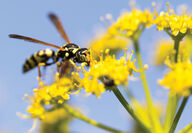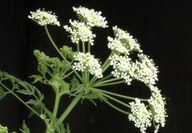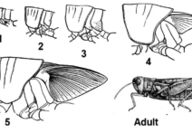Sorted by date Results 51 - 75 of 93
While winter may seem like a long way off, now is the time to start testing your feed as you inventor the amount you have to get you through the winter months. Winter feed costs, on average, account for 65-70% of production costs for a cow-calf operation. Having a feed analysis done will allow you to match your available feed options with your animal’s nutrient requirements in a cost-effective manner. Feeding in excess of your animal’s nutrient requirements is not only cost inefficient, it also isn’t beneficial to your livestock’s perform...
Sorghum, sudangrass, and sorghum-sudangrass hybrids are a great warm season forage option. However, these plants contain cyanogenic glycosides that can be converted to hydrocyanic acid (HCN), also known as prussic acid, when the plants are injured by freezing, cutting, or crushing. Prussic acid can be very toxic to livestock as it interferes with aerobic metabolism, which results in lack of oxygen and ultimately leads to suffocation of the animal. Signs of prussic acid poisoning include difficulty breathing, staggering, muscle spasms,...
If you are preparing to plant winter wheat soon, it is important to consider green bridge control to prevent wheat streak mosaic (WSM). Wheat streak mosaic is a viral disease that impacts small grains, including spring wheat and winter wheat, as well as durum, barley, oats, and corn, among other crops. Symptoms of WSM include yellow streaking and mottling, which usually affects the entire plant. Early infections lead to plant stunting. Wheat streak mosaic impacts can range from insignificant up to 100% yield loss. This viral disease is...
As the time to harvest your annual forages draws near and because nitrate toxicity can be fatal for your livestock, it is important to understand the need for nitrate testing. Cereal crops are known to accumulate nitrates with oats being the top accumulator, along with wheat, barley, rye, triticale, spelt, and others. Other problematic crops include sorghum, sudangrass, millet, and corn. Many weed species can accumulate nitrates, as well, such as kochia, pigweed, lambsquarter, quackgrass, and Russian thistle. If you are growing any of these cro...
As breeding season wraps up and weaning time approaches, it is a good time to think about body condition scoring your bulls and cows. A body condition score (BCS) is based on a scale of 1 to 9 with a BCS 1 being extremely thin and a BCS 9 being extremely obese. The optimal score is a BCS 5 up to a BCS 6. A cow in a BCS 5 would have the hooks, pins, and last two ribs visible, and no fat in the brisket area. Bulls typically lose 100-300 pounds throughout the duration of the breeding season, as they have had to travel long distances to cover cows...
If you are preparing to plant winter wheat soon, it is important to consider green bridge control to prevent wheat streak mosaic (WSM). Wheat streak mosaic is a viral disease that impacts small grains, including spring wheat and winter wheat, as well as durum, barley, oats, and corn, among other crops. Symptoms of WSM include yellow streaking and mottling, which usually affects the entire plant. Early infections lead to plant stunting. Wheat streak mosaic impacts can range from insignificant up to 100% yield loss. This viral disease is...

Yellowjackets and other social wasps may be found in large numbers as we enter late summer and through the fall. Most of the wasps are beneficial and feed on garden pests, however, some can become aggressive. Most stings will come from the Western yellowjacket species of wasp. To begin controlling the wasps in your yard, it is important to first properly identify which species is present. The most common wasps in Montana are bald-faced hornets, paper wasps, and Western and aerial yellowjackets....

There are many reasons to support local vendors and attend local farmers markets. Not only are you able to find fresh produce, but you might also find a unique handmade gift or your new favorite treat. Shopping at your local farmers market also provides benefits, including connecting with vendors, eating and supporting local, strengthening your local economy, and eating fresh. By taking trips to the local farmers markets, you are getting the opportunity to connect with vendors and visit with...
Fair time is here! If you plan to support the 4-H youth at the market livestock sale, you may have to make some decisions when you get that animal processed. You will be given a cut sheet on how you would like the carcass broken down. The first division of the whole carcass is the primal cuts. From there, the primal cuts can be further broken down to your specifications. There are some options, and hopefully the following will help you in this process. Primal cuts of beef include the chuck, rib, short loin, sirloin, round, flank, short plate,...
Blister beetles could be considered a beneficial insect as they feed on grasshopper eggs, however, they pose a significant risk. Blister beetles are named for a toxic in their body called cantharidin that causes blisters when it comes in to contact with the skin. This cantharidin is released when beetles are crushed, making it a concern for not only humans, but also for livestock producers, as hay containing blister beetles can be toxic to livestock. Blister beetles feed on crops including sugar beets, canola, potatoes, and alfalfa. Defoliation...

Blister beetles could be considered a beneficial insect as they feed on grasshopper eggs, however, they pose a significant risk. Blister beetles are named for a toxic in their body called cantharidin that causes blisters when it comes in to contact with the skin. This cantharidin is released when beetles are crushed, making it a concern for not only humans, but also for livestock producers, as hay containing blister beetles can be toxic to livestock. Blister beetles feed on crops including sugar...
The Richland County Farmers Market will once again be in Sidney this summer. The market will be held on Saturdays starting July 9 - Oct. 8 from 7:30 a.m. -12 p.m. at the Richland County Courthouse parking lot, on the corner of 2nd St NW and 2nd Ave NW. There will be a variety of produce and handmade items at the market, and this year there will be additional food products available under the new Montana Local Food Choice Act. This act exempts certain homemade food producers from food licensures and requirements. Food that may be sold at the...
As the time to harvest your annual forages draws near and because nitrate toxicity can be fatal for your livestock, it is important to understand the need for nitrate testing. Cereal crops are known to accumulate nitrates with oats being the top accumulator, along with wheat, barley, rye, triticale, spelt, and others. Other problematic crops include sorghum, sudangrass, millet, and corn. Many weed species can accumulate nitrates, as well, such as kochia, pigweed, lambsquarter, quackgrass, and Russian thistle. If you are growing any of these cro...
The Richland County Farmers Market will once again be in Sidney this summer. The market will be held on Saturdays starting July 9 - Oct. 8 from 7:30 a.m. -12 p.m. at the Richland County Courthouse parking lot, on the corner of 2nd St NW and 2nd Ave NW. There will be a variety of produce and handmade items at the market, and this year there will be additional food products available under the new Montana Local Food Choice Act. This act exempts certain homemade food producers from food licensures and requirements. Food that may be sold at the...

An area of poison hemlock has recently been confirmed in Richland County. This plant is toxic to livestock, wildlife, pets, and humans making proper identification and management important. Poison hemlock is a deep tap rooted biennial that can grow from three to eight feet tall. This plant is in the parsley family and its roots have an odor similar to parsley and carrots. During its first year of growth, the plant forms a rosette and typically remains in the vegetative stage. During its second y...

The cool and wet spring delayed grasshopper hatching. However, you may now be seeing small grasshoppers out on your rangelands or in your crops. These small grasshoppers are in the nymphal stages where they progress through 5 instars before becoming an adult (Figures 1 & 2). The nymphal stages are the best time in which to manage grasshoppers. Treatment thresholds that indicated when control measures should be taken are based on the number of grasshoppers per square yard (Table 1). Therefore,...
Alfalfa weevils can be very damaging to your alfalfa stand, beginning with pinholes in the leaves and progressing to defoliation and crown injury in severe cases. The potential for this much damage, especially in years like this when hay is of high value, makes managing for alfalfa weevils very important. The first step in management is proper identification. Adult alfalfa weevils are a beetle typically less than ¼ inch long, with an oblong shape and a snout. They are dark brown and have a stripe down the middle of their back. These adults...
The breeding season may have already begun for some, but it is coming up in the near future for others. Here are a few considerations as you prepare to turn your bulls out. Having a breeding soundness exam (BSE) on your bulls prior to breeding season is critical. To put it into perspective, in one breeding season an individual cow is expected to contribute to one pregnancy, whereas a bull is expected to contribute to 20-50 pregnancies. The BSE that is conducted by your veterinarian includes a physical exam, an exam of the reproductive organs,...
Alfalfa weevils can be very damaging to your alfalfa stand, beginning with pinholes in the leaves and progressing to defoliation and crown injury in severe cases. The potential for this much damage, especially in years like this when hay is of high value, makes managing for alfalfa weevils very important. The first step in management is proper identification. Adult alfalfa weevils are a beetle typically less than ¼ inch long, with an oblong shape and a snout. They are dark brown and have a stripe down the middle of their back. These adults...
The breeding season may have already begun for some, but it is coming up in the near future for others. Here are a few considerations as you prepare to turn your bulls out. Having a breeding soundness exam (BSE) on your bulls prior to breeding season is critical. To put it into perspective, in one breeding season an individual cow is expected to contribute to one pregnancy, whereas a bull is expected to contribute to 20-50 pregnancies. The BSE that is conducted by your veterinarian includes a physical exam, an exam of the reproductive organs,...
MSU Richland County Extension will be hosting an organization meeting for this year’s Richland County Farmer’s Market at 6 p.m., Thursday, May 19 at the MSU Richland County Extension Office, 1499 N Central Ave. If you are a past vendor or are interested in becoming a vendor, you are encouraged to attend this open meeting. Market vendors can sell a variety of products; ranging from handmade items to produce, baked goods, and more. The organization details and safety regulations of food sales at the Richland County Farmer’s Market will be discu...
As your crops and gardens begin to grow, please keep in mind that the MSU Richland County Extension Office is here to assist you with plant and weed identification, insect identification, and plant disease diagnostics. If we are unable to identify or diagnosis your sample in house, we seek the help of the MSU Schutter Diagnostic Lab. This lab processes plant diseases, insects, weeds and plants, and herbicide injury, all free of charge. If you have any samples that need identified or a plant disease that needs diagnosed, please contact the MSU...
MSU Richland County Extension will be hosting an organization meeting for this year’s Richland County Farmer’s Market at 6 p.m., Thursday, May 19 at the MSU Richland County Extension Office, 1499 N Central Ave. If you are a past vendor or are interested in becoming a vendor, you are encouraged to attend this open meeting. Market vendors can sell a variety of products; ranging from handmade items to produce, baked goods, and more. The organization details and safety regulations of food sales at the Richland County Farmer’s Market will be discu...
MSU Richland County Extension will be hosting an organization meeting for this year’s Richland County Farmer’s Market at 6 p.m., Thursday, May 19 at the MSU Richland County Extension Office, 1499 N Central Ave. If you are a past vendor or are interested in becoming a vendor, you are encouraged to attend this open meeting. Market vendors can sell a variety of products; ranging from handmade items to produce, baked goods, and more. The organization details and safety regulations of food sales at the Richland County Farmer’s Market will be discu...
As grass begins to grow following the much-needed moisture, there is a potential for grass tetany to occur. Grass tetany is a serious metabolic disorder in cattle that is a result of two issues occurring simultaneously: 1) lactating animals have high magnesium requirements, and 2) lush, green grass is low in magnesium and unable to meet such requirements. Grass tetany is caused by low levels of magnesium in the blood and affects lactating cows grazing lush, green grass. Magnesium requirements are high in lactating animals and increase as their...